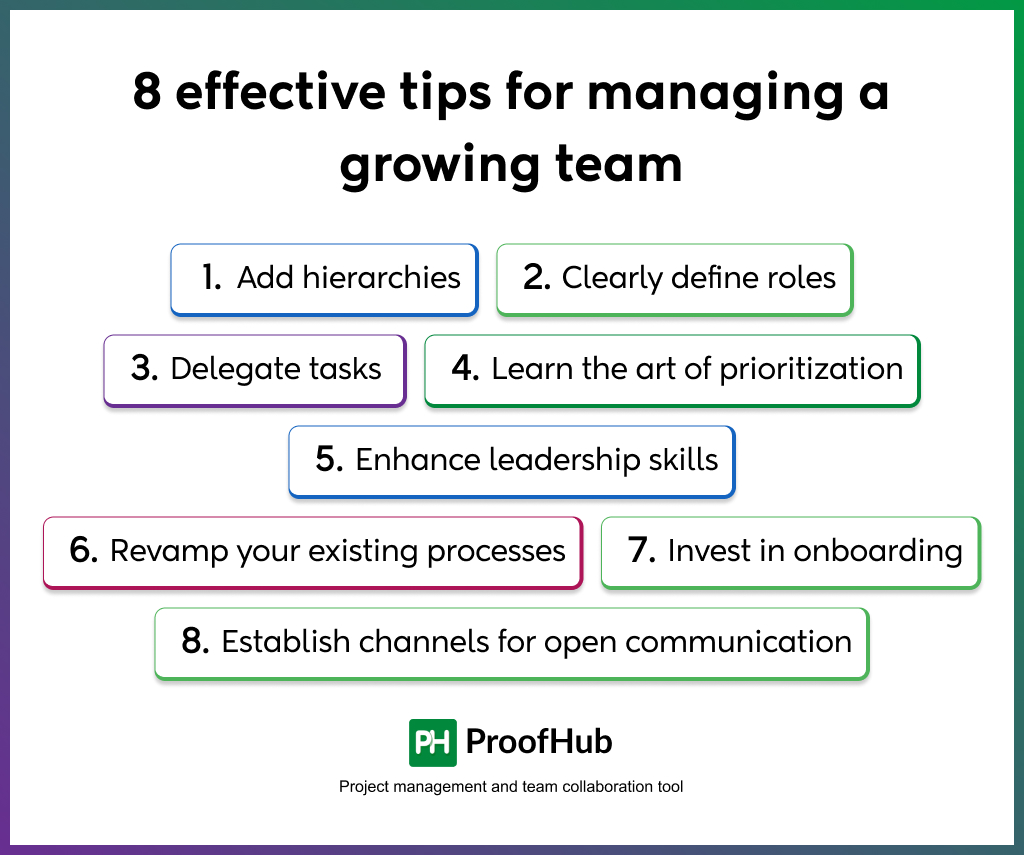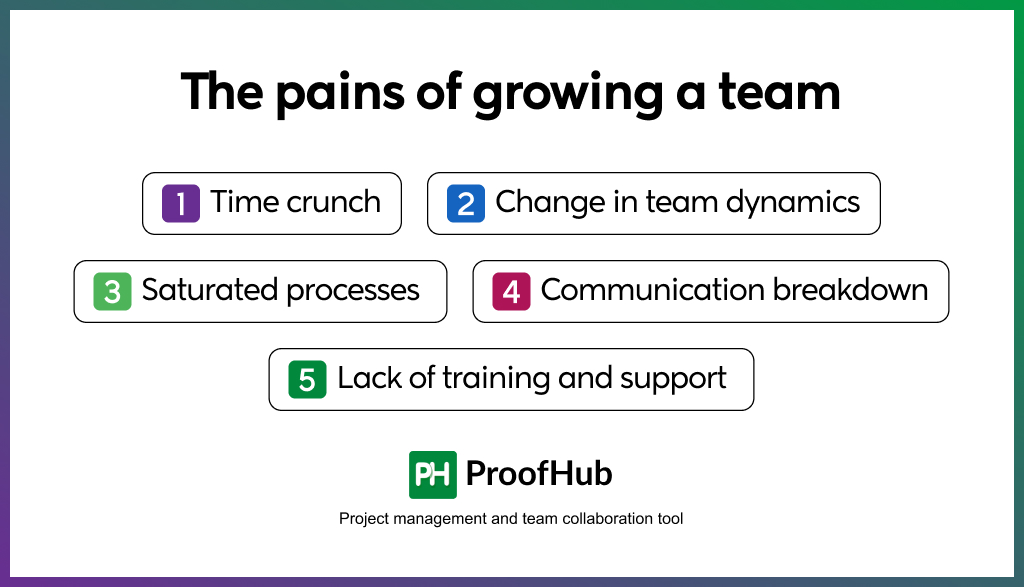Growth is always exciting.
You know you are doing well, have more projects in line, and need more resources. But experienced campaigners know it does not come that easy. There are some sweet growing pains associated with it.
I understand you are excited to solve them, but sometimes you do not have the right processes, systems, and skills at the place. One just feels overwhelmed by the growth.
As a manager, you face many challenges daily while managing a growing team, such as the probability of a shift in team dynamics, changing responsibilities, power clashes, and unscalable processes, just to name a few.
But the good thing is you can solve all these challenges with the right approach.
In this post, I will discuss the pains of a growing team and effective tips to help you manage a growing team. This will help you understand how to manage a growing team.
What is a growing team?
A growing team is when you add more people to the team to cater to the expanded scope of your work. It involves hiring new resources and managing more projects.
Many people confuse growing with scaling, but it is different. Growing means adding revenue at the same pace you are adding resources, whereas scaling means adding revenue at a much greater rate than cost.
8 effective tips for managing a growing team
The pains of a growing team can be effectively resolved if you follow the right approach. Companies like Google, Facebook, Amazon, and others have done it successfully.
Here are the 8 tips that can help you manage a growing team:
1. Add hierarchies

The best way to manage a growing team is to add hierarchies. It is because you simply cannot effectively manage 100 people alone. It would be great if you had a team of 10 subordinate leaders under you who were there to help you manage your growing team.
This way, every subordinate leader has 10 people under their team. And you have 10 subordinate leaders to manage rather than 100 team members.
Adding hierarchies ensures the voice of every team member is heard and everyone is supported.
Many experts hate the concept of hierarchy because it eliminates the direct contact of the leader with the employees working on the ground or makes the leader unapproachable. But with the right practices, processes, culture, and tools in place, hierarchy can help you perform your duties better.
Choose the right leaders, set up the standardized processes, and trust your leaders to do the job.
Read more: How to manage Team management and collaboration!
2. Clearly define roles and responsibilities
Managing 5-10 people is a different thing. You know the role of everyone, who is working on what, and how a task is to be performed. But for a growing team, you cannot remember who is responsible for what without documentation.
Clearly define and document the roles and responsibilities of team members at each level. It not only helps you but also helps team members clearly understand their roles and responsibilities.
I have seen many managers using RACI charts to outline the roles and responsibilities of team members. You can try it too.
A RACI chart provides you with information on the following four key aspects of a given project:
- who is responsible
- who is accountable
- who to be consulted
- who to be informed
Just ensure the documentation is easily accessible to everyone concerned at the company. It helps everyone know what to do.
3. Delegate tasks
With the team growth, the number of projects you share, review workload, and team meetings also increase. Delegating work to responsible and competent team members will help you shed some burden off your shoulders.
You can do so by adding hierarchies such as team leader and assistant manager to review the work of team members. Or you can utilize peer review to ensure the work of every team member is evaluated.
If you are worried there will be lapses in review, you can train the team members on new duties and oversee how they perform unless they are experts in it. Also, you can step in from time to time to check that everything is going smoothly.
4. Learn the art of prioritization
When managing a large team, something will be left at the end of the day. You have to prioritize the tasks you need to do in a day. Otherwise, you will be burned out soon.
Learn the art of prioritization. One simple way to do it is to list all the tasks you must do in a day on a note-taking app and label the priority: high, low, or medium. It will help you better decide on which tasks you need to attempt.
Apart from that, you can also use the time batching technique to effectively utilize your time. It included batching similar tasks together in a fixed interval of time. This will help you save from the productivity loss resulting from switching from one task to another.
5. Enhance leadership skills
New team members look up to the leader for guidance. Therefore, you must perform this duty well, as good leadership paves the way for new team members to have a fruitful journey in the company.
Apart from being a good manager, you must also be a good leader. Look at the leadership skills you need to manage a growing team.
Here are the top leadership skills you need to build:
- Clear and open communication
- Active listening
- Adaptability and flexibility
- Mentorship and coaching
- Decision-making and problem-solving
- Visionary leadership
- Emotional intelligence
- Resilience and stress management
- Conflict resolution and team building
6. Revamp your existing processes
Working with a small team will most likely result in processes that are not scalable. Revamp your existing inefficient, clunky, and unscalable processes.
Get your internal subject matter experts and key stakeholders in. Create and document the processes and workflows to handle the increased workload and complexity.
Remember that while revamping the existing processes, you may have to change the tools and workflows you used earlier.
For example, if you use online spreadsheets to collaborate on work with a group of 5-10 people, you cannot use the same spreadsheet to manage the work of multiple teams.
This will create a lot of chaos, miscommunication, and errors. Also, it will not be an efficient way to work together.
You have to switch to a project management tool and create workflows that can scale at the organizational level.
Be ready to embrace the change.
7. Invest in onboarding and training
If you want to keep your values, work culture, and team environment intact, you must invest significantly in onboarding and training new hires. Otherwise, you can easily find your work culture thrown out of place by adding new team members to the team.
Create a standard onboarding program for a new hire. Involve the HR, learning & development department, and potential team members to share onboarding responsibilities.
Identify the right candidates for peer mentoring and train them. Create learning resources to help new hires get the right information at the right time.
When done right, onboarding can empower new members to learn quickly, acclimate to a new work environment, and become self-sufficient.
8. Establish channels for open communication
When a team grows, you cannot work as closely with everyone as you would with a small group. On top of that, adding hierarchies can make you feel you are losing control and unable to build a personal bond or connection with everyone.
But to overcome that, you can take a few steps forward.
Step 1: Establish channels for open communication. To do so, invest in communication tools for your team, such as ProofHub, where everyone can reach out to you without hesitation.
Step 2: Schedule a regular group meeting with the team for feedback.
If you think team members at lower hierarchy levels are hesitant to speak, you can take charge by clarifying that you welcome dissenting opinions.
Statements like, “I may be totally wrong here,” “Feel free to tell me if you disagree,” and “If you were me, what would you do in this situation?” will help new hires open up.
Step 3: Involve the team members in monthly playing activities and events. These informal interactions help a lot in knowing about the team members who might not open up to you directly.
Apart from that, wherever possible, recognize success and appreciate team efforts. It will help you form a good professional relationship with your team.
I hope these strategies for managing a growing team will help you effectively solve the challenges posed by a growing team.
Do you know that 56% of companies use online collaboration platforms for team communication?
Check out thetop 18 team management software to keep your teams organized.
The pains of growing a team
As you add new people to the team, there is a possibility that old-fashioned ways of doing things might not work. Have a look at the pains of growing a team.

1. Time crunch
The first and biggest challenge a manager faces is the time crunch. You have to manage more people, review everyone’s work, back-to-back meetings, and have much more on your plate.
Not only that but the time you give to each team member is also reduced. For example, if you had 15 people earlier but added 15 more members, your time is split into 30 members now.
Don’t forget if you have to add more people in the future. You are stretched too thin.
2. Change in team dynamics
Each new team member brings something new to the table. If you are growing slowly, the new team member can easily fit into the current team environment and culture.
However, adding 5-10 people or more to the team in a very short span can change the existing team dynamics significantly. It is because each team member comes from a different culture.
Rather than fitting into your culture, they create their way of working. This can even lead to team conflicts between new hires and existing employees.
3. Saturated processes
Working with a team that can fit around a table is entirely different from working with a team of 50 or more people.
For example, now you cannot discuss what your team has done throughout the day just by simply going to each team member’s desk. It may work with two to five team members but not with a growing team.
This shows that your current processes are not scalable enough to handle the growing team’s needs. This is just one example. It can happen with every other process, whether work processes, payroll management, IT support, or inventory management.
4. Communication breakdown
It is easy to keep a cohesive bond with a small team. You can regularly have one-to-one conversations with team members, follow up on action items, and support everyone.
Not just that, after working together for a decent time, you can even start getting to know the team members outside of professional life.
But when a team grows, having the same cohesive bond with everyone is almost impossible. It is not that you don’t want it, but you do not have the time for it.
This leads to a loss of direct communication and disengagement and may dilute your relationship with the team.
5. Lack of training and support
New team members need training and take time to acclimate to the current work environment. A manager plays a big role in ensuring so.
Training one or two new members is easy as it does not take a big toll on your time. But when you add team members in large numbers, you need a dedicated team for onboarding and training new hires.
Without proper support, new hires feel overwhelmed and struggle to contribute effectively.
Wrapping-up: a growing team is an opportunity to break the glass ceiling
Business growth is an exciting journey, but at the same time, it comes with its fair share of challenges. A growing team is an invitation to change. The one who is flexible and adaptable to change can easily encounter the challenges of a growing team.
When a growing team is managed properly, it fuels and sustains the company’s growth. But when the pains of a growing team are ignored, it can lead to failure, too. Therefore, you must adopt the right team management strategies, processes, and tools to manage a growing team.
ProofHub is all-in-one project management and team collaboration software ideal for growing entrepreneurs and businesses to help scale. It helps you create scalable processes and provides the platform to manage a growing team’s increasing workload and complexities.
You can first-hand experience how ProofHub can help you manage a growing team with a 14-day free trial.
Related articles:
- How to manage hybrid teams for success
- 5 awesome ways to celebrate team success together
- Managing underperforming employees: 11 actionable tips
- 5 leadership skills you need to build a strong team
FAQs:
Why is it difficult to manage growing teams?
It is difficult to manage a growing team because you only have 8 hours a day, but your responsibilities increase manifold. You cannot do everything all on your own, from project reviews to meetings, evaluations, announcements, and much more.
What critical mistakes should be avoided when managing a growing team?
Hurrying recruitment is one of the biggest mistakes you should avoid. When you are in a hurry, you may end up hiring people who are not the right cultural fit for your organization. These new hires can disturb the current team dynamics.
What are the three criteria for a successful team?
The top three criteria of a successful team are effective collaboration, alignment with business goals, and trust between team members. These ensure the team works cohesively and effectively to achieve the business goals.

